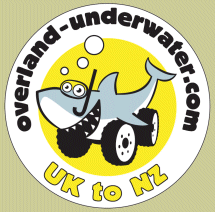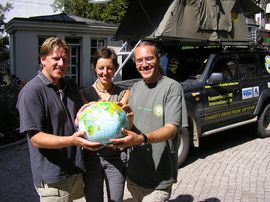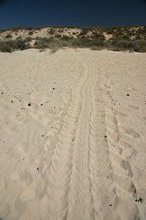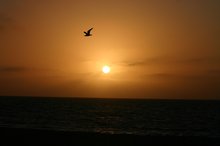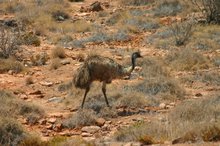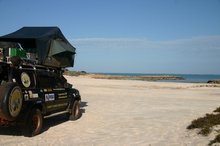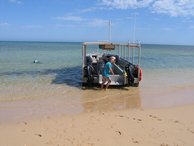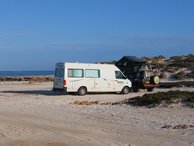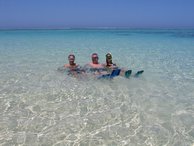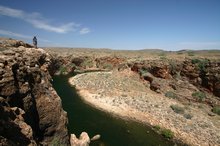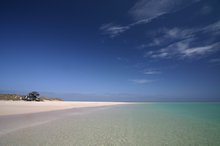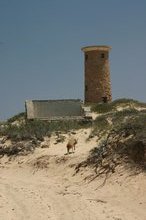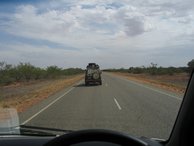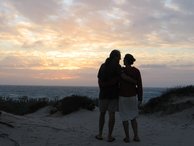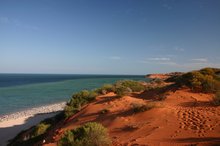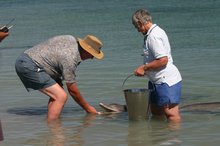| Final Statistics: Alex & Maz | Total distance: 93,550km |
| Furthest Point: Rotorua, NZ | Now settled in Sydney, Australia |
| Final Statistics: Martin | Total distance: 79,698km |
| Furthest Point: Hobart, Australia | Now settled in Bristol, UK |
Kellys Go Commando!
Australia, Country 26, Diary entry 13th - 22nd Dec 2006, Total distance in Australia: Unknown, Distance to date: 18,291KM
Part 2 of the Grey Nomad Trilogy
In the next phase of our journey with Marianne and Alex, we travelled from the land-lock wonders of Karijini to Exmouth, on the North Western Cape. During the journey we marvelled at how 'Tinfish' was surviving the journey from the UK and how much better it was adapted to cope with the wilderness than the 'Grey Nomad' campervan. At the drop of a tailgate a meal could be produced, the washing up completed and water bottles filled before we could even start to sort out arrangements in the campervan. A little later we wished that we had not marvelled so much as the warning light showing the front wheel differential lock appeared again - an intermittent fault that had already caused much concern and would do so for the rest of our stay. A fault which could only be solved by engaging 'Tinfish' into low ratio and slowly wiggling her tail as it progressed slowly down the side of the road until the offending light went off!
In addition to some concern about 'Tinfish', the next part of our trip, an expedition down the Western Coastline of Australia, was to provide us with experiences which we were not expecting.
On our first afternoon we discovered that the Western shore of the North West Cape near Exmouth is one of the world's major breeding areas for the sea turtle and, with impeccable timing, we had arrived at the turtle rookeries right in the middle of the egg laying season. So that evening, at sunset, we went to Jansz beach to turtle watch. Sadly it was a night without moonlight so spotting the arrival of turtles on the beach was difficult. After a patient wait, whispering to each other as we sat on the beach and peered into the gloom, gradually the rounded, shuffling shapes emerged out of the surf line and slowly crawled up the beach.
We had been warned of local community expectations by the 'Code of Conduct' and had been met by volunteer wardens on the beach, so we had little choice but to 'assume the position' This position was decreed by the wardens who demonstrated what can only be described as a slow form of commando crawl. So we, grey nomads and all (much to the amusement of the younger generation!), slowly crawled what seemed like a hundred yards, approaching the nesting to watch as they pitted, dug the egg chamber and laid the eggs. Sadly no photographs as lights were also prohibited on the beach but there was a tremendous sense of being in at the start of one of nature's rare wonders.
The younger end of the family went diving the next day...
Alex: Ningaloo Reef to the diving fraternity is synonymous with the infamous whale shark... the largest fish in the sea, a gentle giant which can grow as long as 18m, weighing a colossal 21 tonnes and visits these shores each year to dine on plankton. Of course it does in season and true to our form in searching endlessly for one of these monsters, we were out of season. Not even the side attraction of Mantas were in season, however with us yet to dip our toes in the waters around Australia, we were keen to see what Ningaloo Reef had to offer.
This is Western Australia's own version of the barrier reef, stretching 250km along North West Cape peninsula and one thing that makes it unique is that it lies only 100m offshore in many places along the peninsula. We joined Village Dive on a mornings dive and with the waters being somewhat fresher in these parts they let us use some of their thicker wetsuits which we were thankful for. They also realised that we knew what we were doing (we're good actors!) and let us go in without a guide - perfect! The first dive was on Blizzard Ridge, a small outcrop running about 100m. We were shown a sketch of the dive site and then we submerged.
Although there were a few fish loitering about, we weren't instantly blown away, although we did manage to sneak up on a few huge groupers resting on the bottom. On the way back towards the boat, we bumped into another pair who frantically pointed in the direction from which they came. We hardly expected it to be significantly different, but how wrong were we? Fish soup... snapper, shark, sea snakes, grouper, etc, etc. It was like a totally different spot and I quickly used up the rest of my film creeping up on the resting white tip sharks to see how close I could get to take a snap before they swam off and around the block. 76mins later we surfaced.
After a few surface interval cookies, we were subtly asked if we'd keep the next dive to 60mins as they have a schedule to keep. Before we knew it we were back underwater at Gulliver's, which looks something like a huge footprint. Again we were met with a myriad of fish and were very much enjoying our aquarium experience. At one point we kept getting buzzed by a grey reef shark who relentlessly circled us and flicked his tail... I think he was just biging it up for the camera! True to our word after 56mins we were back on the boat having thoroughly enjoyed our two dives, we only hoped Jim & Barbara where having as good a day. Thanks to the guys at Village Dive, they were a great bunch who made us feel right at home.
The grey nomads had a 'rest day' to get over the beach crawling and went for a gentle excursion in a glass bottomed boat, through which we enjoyed the spectacle of the marine life of the Ningaloo Reef; with reef sharks, a coloured kaleidoscope of tropical fish, and turtles transformed, swimming with grace and speed in their natural environment. We were encouraged to go snorkelling by the owner of the boat who demonstrated the depth of the water, seemingly shallow from the glass perspective of the boat, by diving fully clothed and swimming under the boat. His demonstration was enough to persuade me to attempt to regain my almost forgotten skills of snorkelling - a reasonably successful venture today which was to have repercussions a couple of days later.
That evening we all met up at Pilgramunna Bay and shared an isolated and idyllic camp site on the water's edge with wild kangaroos, the usual impeccably clean bush toilet (a.k.a. 'long drop') and two German divers who had dived with Marianne and Alex earlier in the day and chose the same beach for the night.
Only one day's rest - then on with the expedition, through the Jurabi coastal reserve to Turquoise Bay - considered to be one of the best snorkel sites on the coast. We were told by the guide books that it was a perfect place for beginners to practice their skills and that one could use the current to cover considerable areas, drifting effortlessly over the reef. It always sounds easier in the book that it is in reality!
Alex accompanied me, feeling confident following my experience the previous day, at first all went well. Then a mask and snorkel, both full of sea water at the same time, both highlighted inexperience and also caused a minor crisis. After a very prompt 'rescue' by Alex, I snorkelled on but with considerably greater care and several chunks out of my leg after bumping into the reef.
On the distaff side, Barbara was less adventurous but just as successful in sharing undersea wonders with Marianne. And what wonders! There was some ribald speculation about what exactly they were looking for, but they both reported an enjoyable afternoon!
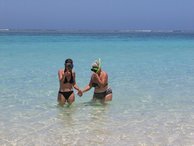
|
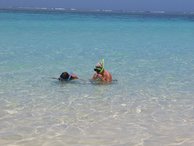
|
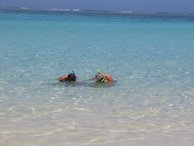
|
Again the call of the 'off road' track and the limitations of the campervan caused our paths to briefly diverge, with the younger generation carrying on down through the Cape Range National Park to cross Yardie Creek whilst the grey nomads retraced their steps, staying on sealed roads, sneaked a meal at an Italian restaurant in Exmouth before we drove on to Coral Bay whose name says it all, our rendezvous with Marianne and Alex.
Alex: Having reached Yardie Creek and read the notices of extreme off-roading which lay ahead, after a quick stretch of the legs along the creek walk (where I swallowed my first fly ![]() ), we deflate tyres once more and left the tarmac behind. The track unsurprisingly wasn't that bad, narrow and a bit corrugated, but the main hazard were the countless kangaroos who were resting in the shade under the low trees which lined the road. At the last minute they'd bounce out, sometimes right in front of the car, so you had to keep concentrating so as not to hit one. With the continual wind blowing in this part of the world, we were on the lookout for a camp with a bit of shelter.
), we deflate tyres once more and left the tarmac behind. The track unsurprisingly wasn't that bad, narrow and a bit corrugated, but the main hazard were the countless kangaroos who were resting in the shade under the low trees which lined the road. At the last minute they'd bounce out, sometimes right in front of the car, so you had to keep concentrating so as not to hit one. With the continual wind blowing in this part of the world, we were on the lookout for a camp with a bit of shelter.
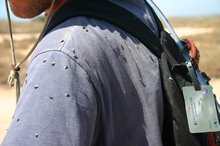
|
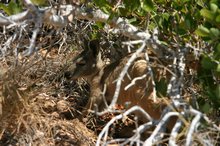
|
We spotted a sand peninsula that stretched out to form a bay of perfect turquoise water which rippled against the soft white sand. It looked idyllic enough and we'd also have our backs to the wind, so off we meandered down deep sand tracks following our nose to the end. Beautiful! With camp set up, time for a quick dip before dinner and with the beach all to ourselves, clothes were left behind. Now this is the type of camp which makes it all worthwhile.
The following morning we went for another quick dip and were just back at the car sorting ourselves out, when I heard a familiar sound... an engine. Peering from around the car, there indeed was another 4x4 plodding its way up the beach and quite close. Maz happened to be leaning in through the drivers door, so they must have been very surprised to see the moon still out! Laughing at our predicament, we waved them past and tucked into some brekkie.
With camp packed away, the last thing to do was shower off to wash away the salt, so out came our alfresco shower. No sooner were we stripped off and soaped up, when there was that familiar noise again... they were driving back the other way! Why does it always happen at this precise moment! With our rendezvous in mind we continued along to Coral Bay stopping off at an historic lighthouse, perched high amongst the sand dunes, to admire the views. It must have been a lonely life for the lighthouse keeper and his family back in those days. Although there is a homestead towards the beach now, at least they have all the modern creature comforts to keep themselves amused. The early settlers here were a hardy bunch!
Having met up in Coral Bay, after watching the snappers being fed as they visited the shore for their daily feed, we continued, once again in convoy as we cruised towards Quobba. On our way we passed the remote, windblown memorial to HMAS Sydney.
On 19 November 1941, following a battle with the German raider HSK Kormoran, in the Indian Ocean off the Western Australian coast, the light cruiser HMAS Sydney disappeared, almost without trace. The loss of the HMAS Sydney with its full war complement of 645 sailors remains to this day Australia's worst naval disaster and one of its greatest wartime mysteries.
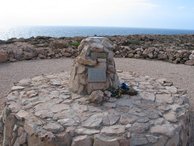
|
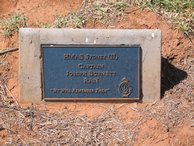
|
Local respect for and memory of that loss is reflected in the numerous memorials which have been erected in memory of those lost, including a simple cone facing out to sea on the coast where the ship was lost and also, in Carnarvon, a forlorn and windswept 'Memorial Drive' of palm trees with monument stones in the names of every member of the crew.

|
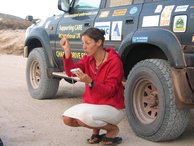
|
That evening we camped in the dunes, and enjoyed an excellent campfire meal. Alex displayed both his bush skills and also his South African fire tripod which made cooking on a bush fire look easy. He also managed, at the same time, to take good notice of Marianne as she pursued more important business!
However all good things come to an end - and with the sun and sky in celebration mood that evening, we all enjoyed a spectacular end to the day.
When we first arrived, in the late afternoon at Quobba to see the blowholes, they we rather disappointing. But the next morning when we returned we were in for a treat. The blowholes lived up to their name, shooting fountains of water high into the air while the waves roared and crashed against the jagged cliffs. A spectacular and surprising sight as fifty yards from the shoe the sea moved calmly in the normal ebb and flow of the tide.
The remainder of the day was taken up with the drive to Denham, where we would be based for our stay in Shark Bay. Since 1991, this area has joined places like the Galapagos Islands, The Great Barrier Reef and The Grand Canyon as a site so universally significant that it satisfies all four criteria for a World Heritage listing. To explore this area four wheel drive was essential, so the grey nomad campervan became a store house for kit so that Tinfish could take us all to enjoy the breathtaking scenery of Shark Bay with its stunning, red sand dunes beside the brilliant white beaches and crystal blue of the Ocean - a great spot for a break for lunch.
After lunch - on to Cape Peron, along a track which required many of the off road capabilities of Tinfish as well as Alex's knowledge of how best to drive in desert sand as we experienced four wheel driving in the wild..
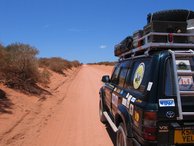
|
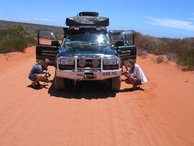
|
We learned the importance of partially deflated tyres to ease driving on the desert like sand of the outback. Alex and Marianne had perfected a system of dual deflation; with each starting deflate their tyre at a shouted command, stopping at the next command to measure pressure, eventually completing the exercise by smaller individual adjustments to the pressure to balance the steering. Quite a mirror act when you witness it for the first time.
The journey to Cape Peron was well worth the trouble as we experienced a range of natural wonders. From the cliff top we watched as Rays, Guitar Fish, shoals of Snapper and Sharks swam in the crystal clear water of what seemed like a giant aquarium. Just around the cliff, along the Wanamalu Trail, we looked on as a colony of cormorants shuffled on the rocky cliff to protect their nesting places and feed their hungry offspring with fish caught in the nearby sea.
Spectacular though Cape Peron was, the best was yet to come in Monkey Mia the following morning. We had been warned that an early start was needed to catch the feeding of the Dolphins. These wild dolphins have been visiting Monkey Mia since the 1960's and a careful regime has been put in place by CALM to ensure that the dolphins are not overfed or tamed to such a degree that they cannot flourish in the wild. Feeding of the wild dolphins is carefully supervised, so I was absolutely delighted when I was chosen as one of the feeders. Seeing the dolphins at close quarters was something that I was very much looking forward to, so taking part in the feeding proved to be one of the highlights of this part of the trip for me.
to be continued...
| All content copyright � overland-underwater.com - please do not use without permission. |
| Comment from Chris ODonnell |
| mmmmmm is that a silver BA card on your rucksack Alex???!!! |
| 08 Feb 2007 @ 03:51:18 |
